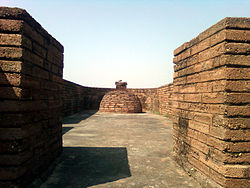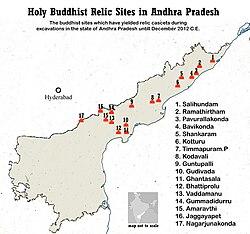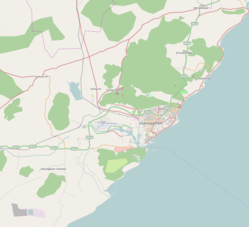Bavikonda Buddhist Complex lies about 16 km from Visakhapatnam, in the Indian state of Andhra Pradesh, on a hill about 130 metres above mean sea level. The term Bavikonda in Telugu means a hill of wells. As per its name, Bavikonda is a hill which has wells for the collection of rainwater. Bavikonda[1] Monastic ruins dates back to the 3rd century BCE.
Bavikonda | |
|---|---|
Protected Buddhist monument complex | |
 | |
| Coordinates: 17°49′2″N 83°23′27″E / 17.81722°N 83.39083°E | |
| Country | |
| State | Andhra Pradesh |
| District | Visakhapatnam |
| Languages | |
| • Official | Telugu |
| Time zone | UTC+5:30 (IST) |
| Vehicle registration | AP |
| Nearest city | Visakhapatnam |

A large Buddhist complex was excavated at this site. The excavated remnants are as follows:
- A piece of bone stored in an urn, supposed to be one of the remains of the Buddha,
- Inscriptions,
- Pottery,[2]
- Relic caskets,[3]
- Tiles,
- Bricks,
- Coins etc.
were recovered here by the State archaeological Department.[4]
The Buddhist sites of Thotlakonda and Pavurallakonda are situated close by.
The Indian National Trust for Arts and Cultural Heritage (INTACH) has already appealed to the authorities to ensure better protection of Buddhist sites by taking up the declaration of Bavikonda, Thotlakonda, Pavurallakonda and Bojjannakonda as heritage sites by UNESCO. This will not only pave the way for steady flow of funds but also generate employment opportunities for the locals.[citation needed]
Gallery
edit-
Bavikonda stupas Visakhapatnam
-
A stone stupa at Bavikonda
-
Stupa at Bavikonda near Visakhapatnam
-
Bavikonda Mahastupa Visakhapatnam
-
Walls of Apsidal stupa at Bavikonda
-
Votive Stupa at Bavikonda Visakhapatnam
-
Vihara at Bavikonda Visakhapatnam
-
Votive stupas at Bavikonda
-
View at Bavikonda in Visakhapatnam
-
Bricks on a votive stupa at Bavikonda
References
edit- ^ "Bavikonda: A Buddhist Site in North Coastal Andhra Pradesh". Department of Archaeology & Museums, Government of Andhra Pradesh. 1994.
- ^ "Journal of the Andhra Historical Research Society Volume 39". Andhra Historical Research Society. 1995.
- ^ "Buddhist Relic-Caskets In South India". Bharatiya Kala Prakashan.
- ^ "Dept. Of Archaeology & Museums". Archived from the original on 9 February 2012. Retrieved 24 October 2012.
